Cab replacement: now, later, or even at all?
|
So I'll start by saying that I don't *want* to do a frame off restoration. It would be fun but it would take an eternity with all the demands on my time. However it's becoming clear that the roof of my cab is an issue that will need to be addressed at some point. According to the previous owner, the roof had a run-in with some fire wood and was bondo'd back together and then calked with black silicone (pictures below). During rains it leaks into the drivers side cab floor, which has rusted through such that you can see the street below - which indicates that the roof leak predates the firewood incident. He also Bondo'd the doors which I'd love to replace at some point and maybe even pretty her up with a decent pain job... dreams of course.
I would like to wait until it's road worthy but part of me is wondering if I need to disassemble everything now, get a new cab (somewhere) and install it first, and then get to attacking the rest of the vehicle. Even if I did ignore the cab roof skin I'm going to eventually have to address the drivers side floor pan and threshold which is exciting because it means I get to learn to weld. But maybe I should just consider a full cab replacement. For context, the list of must-haves (for inspection and registration) is as follows: - Brake system overhaul - Suspension overhaul (all original and dangerous rust) - Thermactor re-install (for smog requirements) - Oil pan gasket replacement I guess all this leads up to my question: Would you replace the cab now or later (or at all)? How much needs to be removed from the engine bay to pull the cab out? How difficult is a cab replacement? and most importantly, what would you all do in my situation? On a completely unrelated note, does anyone out there have a good lead on a thermactor diverter valve for a 1984 4.9l 300 engine? it's one of the rare parts I can't find online. Thanks for your help in advance! Previous owner's Bondo and silicone calk job. 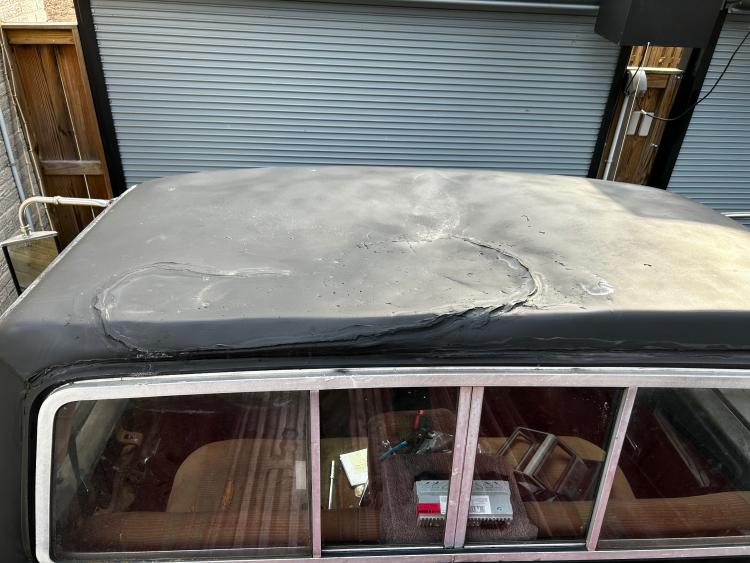 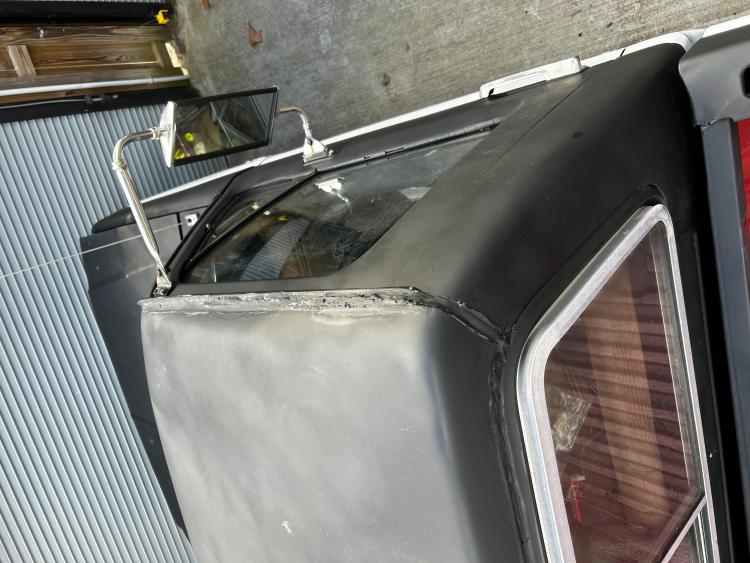  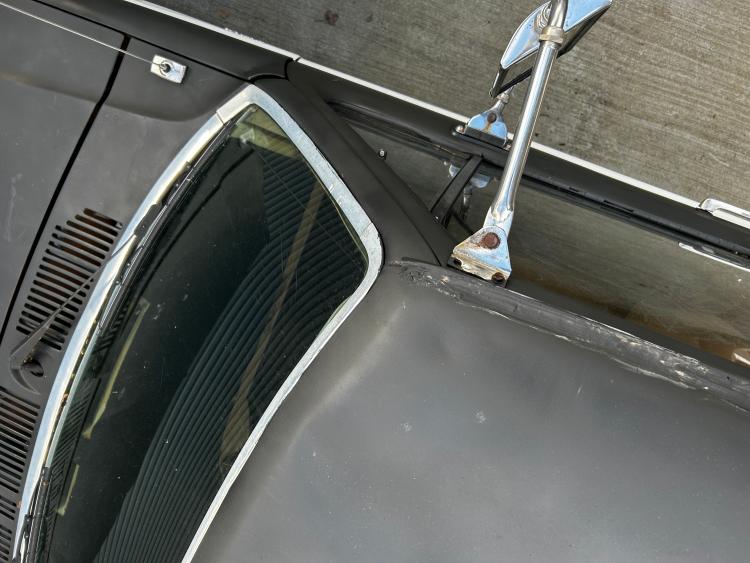 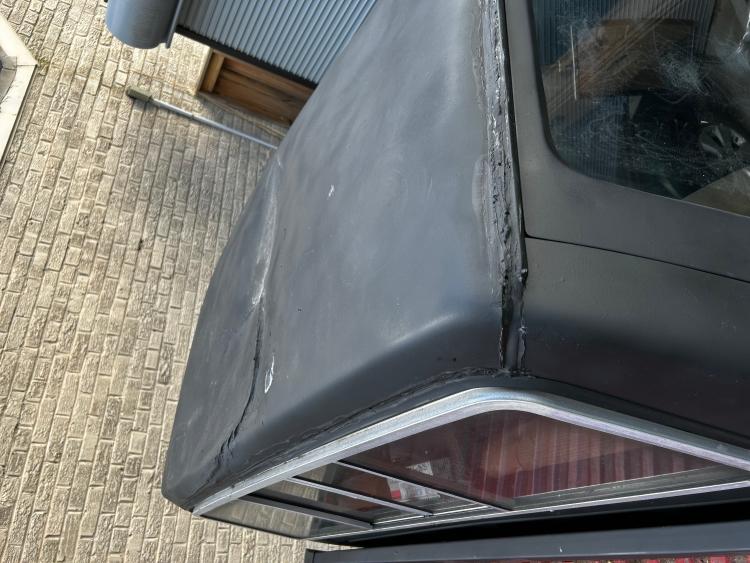 My burned out diverter valve that I need to find a replacement for... 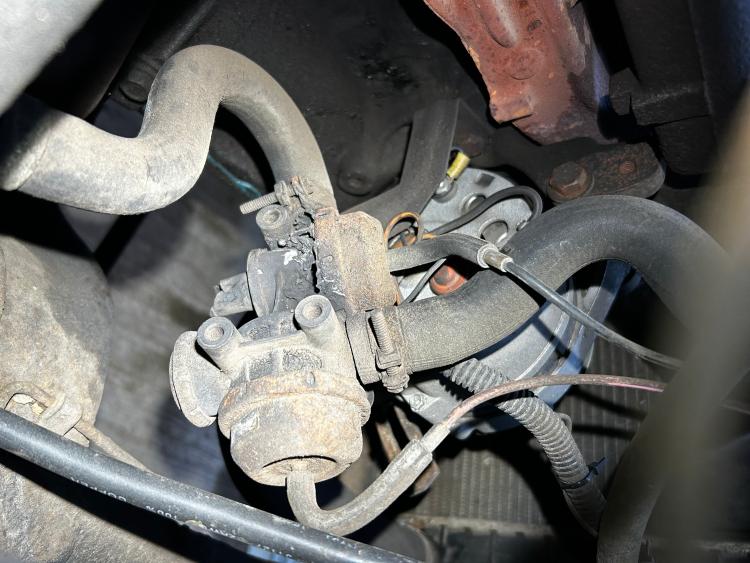
Jon
1984 Single Cab F150 300/4.9L i6 named 'Dolly' 4X4 - rear 3.55 limited slip, Dana 44 and nothing fancy ... yet. |
Re: Cab replacement: now, later, or even at all?
|
Administrator
|
Jon - Do you have emissions testing where you live? That makes a big difference.
The best way to fix all of this is with a replacement cab. And the easy way to do that is to buy a donor truck with a good cab but bad something else so it is cheap. Then you disconnect the wiring, unbolt the cab, raise it up, and roll your frame/engine/bed under it. The wiring runs from the driver's headlight back through the cab and forward to the passenger's headlight. So you can leave everything in the cab and disconnect from the engine harness and other things under the hood. Remove the fenders and pull the 4 bolts that hold the cab on and it'll come off. BUT! You need a cab wired like yours. And in 1980 there were differences so don't go with an '80. And from 1981 through 1985 there were trucks with gauges and trucks with idiot lights, and the wiring is different between them. And there's A/C and non-A/C. So you have to pick one like yours.
Gary, AKA "Gary fellow": Profile
Dad's: '81 F150 Ranger XLT 4x4: Down for restomod: Full-roller "stroked 351M" w/Trick Flow heads & intake, EEC-V SEFI/E4OD/3.50 gears w/Kevlar clutches
|
|
In reply to this post by Jon M
I would assess the rust damage further if you haven't already and find where that leak is before making a move. That paint could be hiding something spooky underneath and it could just be the picture but it looks like the back window isn't sitting in there just right, maybe pull it out and inspect? My Bronco was parked for a number of years with the windows down and similarly had rust damage from water intrusion. The worst spots were the driver-side floorboard like yours and the door sills on both sides.
To yank the cab you'd have to pull off the hood and front fenders and everything attached to them. Disconnect every bit of the wire harness that runs through the firewall, brake lines between master cylinder and proportioning valve or the master cylinder itself, parking brake, throttle cable, cruise control cable (if any), windshield washer lines, ground straps, A/C lines (if any), heater lines, transmission linkage if it's an auto, steering shaft or the whole column, probably more I'm forgetting but these are largely easy things. Then transfer everything over to the new cab including the dash, wire harness, etc etc. From my experience (I didn't pull the cab off my Bronco but I have had it nearly completely disassembled) there are some extra things you would likely need to do work on. If the brake lines are seized at the flare nut you have break them off to remove and bend new lines. though I suppose you could just pull the master cylinder off the brake booster/firewall and support it without losing any juice. Body mounts are a complete pain if the bolt comes out in 2 pieces and the correct replacement parts are hard to find (and aftermarket ones are totally wrong), I've had to cut several of mine apart. I would probably drain and refill the coolant and brake fluid since you're already opening the system. I'm also thinking it might be difficult to find a cab that you're satisfied with. Not only would you have to find the correct one for your transmission and A/C or lack thereof, but one that is free from damage and heavy rust. It would be way more work than a patch and paint, and you'd probably break things in the process. I think it's only worth it if you're going to do the whole truck, but you may be a lot more focused than me. I'm already down the rabbit hole of going from getting a truck roadworthy to doing a full restoration and it was frighteningly easy transitioning into that mindset.
1982 Bronco restomod in progress: Built 4.9L, T19 4spd, 9" 3.00 rear w/ Eaton TrueTrac, 31" tires, fuel injection soon
https://www.youtube.com/@jimjamauto |
Re: Cab replacement: now, later, or even at all?
|
In reply to this post by Jon M
When I see something like that, I wonder what happened etc.
Some ideas for you. Ford used to make patch panels for the outer and inner roof and drip rails. They sadly do not any longer, but getting a roof panel from a good cab (or one that has a good roof section at least) to put on this one might be of help? Ford didn't change the outer roof section from 1980-1996. F-100/F-900. Only difference would be cab lights or cargo lamp. The floor and lower cab corner patch panels are already reproduced etc. A heck of a lot of work to be sure, but if you can't find the correct cab, it might be an option. If the cab is too far gone, then getting another cab, and transplanting your firewall to it might be an option as well if you can't find the right one for your truck. One thing for sure, when it's time to seal the truck again, use a auto body sealant such as "3M's all around auto body sealant". You can use it on all the seams, and can be sanded, and is paintable. It can also be used to seal small drill holes. Silicone caulk can actually rust steel, making things worse. Good luck to you in what you decide is best! 
Truck: 1981 F-150 Explorer / Engine: 300-6 California MCU Feedback System / Trans: T-18 - 4 speed / 2.75 Ford Rear Axle Open Diff.
|
Re: Cab replacement: now, later, or even at all?
|
In reply to this post by Jon M
As for your thermactor valve, do you have the engineering part number on the part itself by any chance?
Truck: 1981 F-150 Explorer / Engine: 300-6 California MCU Feedback System / Trans: T-18 - 4 speed / 2.75 Ford Rear Axle Open Diff.
|
|
Administrator
|
In reply to this post by Jon M
I can tell you from experience that cab removal is relatively easy… and a single cab is decently manageable from a weight perspective. Unless you otherwise succumb to scope creep, there is no reason to equate a cab swap with a frame off restoration. With some preparation the swap can be done in a weekend.*
*Provided the cab going on is run-ready… **If it isn’t run-ready and you have to transfer the wiring and interior from your existing cab, allow at least another weekend 😅 Given the issues with your cab, I would say that the labor involved in fixing it is probably not worth it. I can’t speak to the prices or availability in your area, but I would only repair the one you have as a last resort. As far as now vs later, I would vote for sooner rather than later. These things are not getting any easier to find in salvage yards or online as parts trucks. This body style is taking off among hobbyists and I would grab one if you can find one. You will feel better about investing in your project if the body is solid. Gary mentioned that the wiring is very different for 1980. There are more large differences in 1983 (when most to feedback carbs with computers). Note that that 351 HO and 460 engines were non-catalyst and tend to have simpler wiring that is more like the early models. The diesel trucks are also simple and slightly different. The cab wiring is not to difficult to swap if you need to use yours, and is best removed in one shot attached to the dash shell. A full cab wiring removal takes me about 2 hours, and perhaps a bit longer to put it back. The catch is AC vs non AC since the firewall is different and mix matching AC and non AC wiring HVAC cables etc., gets messy very fast. When shopping for a cab, AC vs non AC is more important than the wiring. Learn to recognize dealer added AC as well, as that is a whole different can of worms and the cab should be treated as a non-AC model.
SHORT BED 4-DOOR DIESEL: 1986 F350 4x4 under construction-- 7.3 IDIT ZF5+GVOD
STRAIGHT SIX 4X4: 1981 F150 2wd to 4x4-- 300 I6 close ratio diesel T19, hydroboost brakes, Saginaw steering BIG F: 1995 F-Superduty under construction— converting to 6.9L IDI diesel ZF5+DNE2 |
|
In reply to this post by 81-F150-Explorer
according to the PDFs in the Documentation tab the part number "9F491" but it is definitely discontinued and I don't see aftermarket makes anywhere.
Jon
1984 Single Cab F150 300/4.9L i6 named 'Dolly' 4X4 - rear 3.55 limited slip, Dana 44 and nothing fancy ... yet. |
Re: Cab replacement: now, later, or even at all?
|
Administrator
|
Jon I'm not sure that Jolene is 4wd, but I think it is. And assuming it isn't a California truck and doesn't have the high-altitude calibration there are only 3 calibration parts lists that are for an '84 F150 4wd w/a 300 six: #353; 355; & 364. And all three use the same valve: E43Z 9F491-C or CX-921.
Right, Ralph?
Gary, AKA "Gary fellow": Profile
Dad's: '81 F150 Ranger XLT 4x4: Down for restomod: Full-roller "stroked 351M" w/Trick Flow heads & intake, EEC-V SEFI/E4OD/3.50 gears w/Kevlar clutches
|
|
In reply to this post by Gary Lewis
I do have emissions testing unfortunately. So I feel like it's a risk to leave this unaddressed. Also I'll eventually be trying to register this thing in California and they are notoriously strict on emissions.
As for trading the cab out. I guess I'm going to need to get looking into a donor vehicle... and a place to put it. My truck is a manual transmission, would I have to find a donor truck with that transmission style or would I be able to cut the appropriate holes in the cab floor? I'm quickly finding that not all cabs are created equal. This is going to take some doing.
Jon
1984 Single Cab F150 300/4.9L i6 named 'Dolly' 4X4 - rear 3.55 limited slip, Dana 44 and nothing fancy ... yet. |
|
As someone who is running a 1990 F350 pretending to be a 1980, don't go with a 1987-1996 cab unless you're robbing panels. The newer cabs may look the same, but they have some differences that require a welder and grinder to work around, and definitely some hours into making it all work together. Stick with a 1980-1986 cab if you can and save yourself the headache.
Also, when shopping for a new cab, pay close attention to the firewall. You're not just looking for rust, you're looking for other damage to the firewall like cracks caused by a hydraulic clutch and no reinforcement or a previous owner who lifted the cab by the weak fender mounts and cracked the firewall in the process. |
|
In reply to this post by Gary Lewis
Gary, that sure seems like the part. At least based on a quick internet search. Also looks like it's been discontinued. But at least now I know what I'm looking for, so I should be able to dig and find one somewhere.
Hey everyone else, all my replies seem to be stacking up at the bottom of the page. I want to take a moment and thank you for your time and thoughts. I'm reading everything and taking copious notes! I'll probably change out the cab at some point but I think I'll get ol' Jolene registered first.
Jon
1984 Single Cab F150 300/4.9L i6 named 'Dolly' 4X4 - rear 3.55 limited slip, Dana 44 and nothing fancy ... yet. |
Re: Cab replacement: now, later, or even at all?
|
In reply to this post by Gary Lewis
That looks like the one if the calibration is correct.
I've had no luck finding one either... 
Truck: 1981 F-150 Explorer / Engine: 300-6 California MCU Feedback System / Trans: T-18 - 4 speed / 2.75 Ford Rear Axle Open Diff.
|
Re: Cab replacement: now, later, or even at all?
|
Administrator
|
In reply to this post by Jon M
Given the emissions testing you are going to have to either find a cab from a very similar truck or swap your wiring over. And I think you'll wind up needing to swap your wiring over.
So I'd get Jolene running well and then decide.
Gary, AKA "Gary fellow": Profile
Dad's: '81 F150 Ranger XLT 4x4: Down for restomod: Full-roller "stroked 351M" w/Trick Flow heads & intake, EEC-V SEFI/E4OD/3.50 gears w/Kevlar clutches
|
|
In reply to this post by Jon M
Just an idea... If you buy an EFI 300 truck you can cut off the roof to patch yours, and swap over the EFI engine so passing smog testing is not a pain. Or you can use "alternative solutions" to pass smog if you have connections with people.
1982 Bronco restomod in progress: Built 4.9L, T19 4spd, 9" 3.00 rear w/ Eaton TrueTrac, 31" tires, fuel injection soon
https://www.youtube.com/@jimjamauto |
|
tcbaklash and Gary,
I admit I'm a little lost. Gary you mentioned a new cab being of the same generation will help with emissions. I'm not following what your referring to, can you explain. tcbaklash, curious how different the FI engine is. is it a simple plug-and-play set up where all I have to do is install the engine and trade out some peripherals, or are the other considerations to be aware of? I have considered harvesting the skin from a donor vehicle instead of going all the way with a cab trade out, but my inexperience with welding made me think twice. What's your take on difficulty of welding in a roof skin vice just trading out the cab?
Jon
1984 Single Cab F150 300/4.9L i6 named 'Dolly' 4X4 - rear 3.55 limited slip, Dana 44 and nothing fancy ... yet. |
Re: Cab replacement: now, later, or even at all?
|
Administrator
|
Let me try to explain whatever it was I meant to say before. The cab itself doesn't play into the emissions. But the wiring does. And if you do as I suggested and swap cab and wiring then you want to find a donor that has the same setup as yours.
Initially I thought the fact that yours is a California truck would complicate things as CA had different systems than the 49-state models. But I just looked and even the 49-state F150's with a 300 six had a computer in '84. And some of the other engines did as well, although not the 351HO, 460, or diesel. I don't know that I can tell you which cabs & wiring will work without some research. But if you are going to swap cabs and wiring then you'll need to find one with a EEC-III computer system like yours. As for your question about welding a cab roof on, I'll tell you that I personally would not attempt that. I can weld fairly thick metal and get it to hold, but welding bodies is not on my list. However, I could swap a cab and wiring. But you may be a wonderful welder and hate wiring, so that may be very different for you.
Gary, AKA "Gary fellow": Profile
Dad's: '81 F150 Ranger XLT 4x4: Down for restomod: Full-roller "stroked 351M" w/Trick Flow heads & intake, EEC-V SEFI/E4OD/3.50 gears w/Kevlar clutches
|
Re: Cab replacement: now, later, or even at all?
|
Yes, the cab roof is spot welded and then the seams sealed with sealer. You can see the spot welds where the roof of the cab and "A" and "B" pillars meet, and where the lower roof is spot welded to the top with the windshield and rear window removed. The rear window pinch seam where the window seal rides is where part of the lower and upper roof panels are spot welded together. Similar to how the inner bedsides of a styleside is spot welded to the bed floor and the seams sealed with sealer. The whole roof is similarly attached. I've seen these repairs similarly done at a Ford Dealer body shop in the past.
Not a easy job at all. And those new roof repair panels are long obsolete so you would have to remove a good one from a good cab as well. I'd only do it if I had no other choice etc... , but it is an option.
Truck: 1981 F-150 Explorer / Engine: 300-6 California MCU Feedback System / Trans: T-18 - 4 speed / 2.75 Ford Rear Axle Open Diff.
|
|
In reply to this post by Jon M
California allows engine swaps as long as it is a same year or newer engine with all the emissions equipment. So that means you have to grab the complete engine, wire harness, ECU, anything that is plumbed to vacuum, EGR system, your exhaust from manifold to catalytic converter (and they have to be CARB compliant cats), and your intake from manifold to air inlet. Then you would have to get with the Bureau of Automotive Repair to get it certified and stickered to be held to the same testing standards as the donor vehicle. It's a process, but you will never fear a smog test and you can check diagnostics before you even go in. Can't tell you about the difficulty in doing that, I have very limited experience with body work. I'm with Gary in that I'd never attempt it, just thought it could be an option in combination with an EFI swap.
1982 Bronco restomod in progress: Built 4.9L, T19 4spd, 9" 3.00 rear w/ Eaton TrueTrac, 31" tires, fuel injection soon
https://www.youtube.com/@jimjamauto |
Re: Cab replacement: now, later, or even at all?
|
Administrator
|
If you are up to the electrical work a swap to a later EFI system with the OBD-II port is the way to go. I did it on Big Blue and now when it throws a code, like it did last week with an odd glitch, I put a scanner on and find out what the problem is. Easy peasy.
But it can be a real ordeal as you have to pull EVERYTHING from the donor vehicle. Or another similar vehicle. And the later trucks put the ECU in the left kick panel, but the Bullnose trucks don't have any room in that area. So I put my ECU where Ford put the ECU in '85 trucks - up under the dash behind the radio. But that requires about 36" more wire than is in the later harness, so I added that much wire to mine. I love mine as it starts and runs so well, and my offspring can maintain it or have it maintained with ease since the later systems are MUCH more simple. But it wasn't easy. HOWEVER, if you are changing cabs then you could go to a later cab which has the spot for the ECU in the kick panel and use the original harness. It would be much easier and still work very nicely. But be aware that the VIN is attached to the cab, so...
Gary, AKA "Gary fellow": Profile
Dad's: '81 F150 Ranger XLT 4x4: Down for restomod: Full-roller "stroked 351M" w/Trick Flow heads & intake, EEC-V SEFI/E4OD/3.50 gears w/Kevlar clutches
|
| Edit this page |

